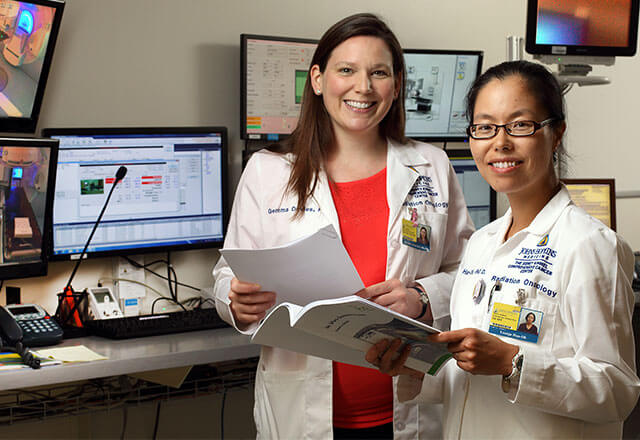-
About
- Health
-
Patient Care
I Want To...
-
Research
I Want To...
Find Research Faculty
Enter the last name, specialty or keyword for your search below.
-
School of Medicine
I Want to...
Bone Marrow Transplant Program
A History of Excellence in Research and Treatment
Watch our video on Bone Marrow Transplant
The Bone Marrow Transplant (BMT) Program at Johns Hopkins is internationally known and it was a Johns Hopkins researcher, George Santos (1928-2001), who more than 40 years ago, established regimens that would lead to bone marrow transplantation -- the process of taking marrow from a healthy donor and injecting it into a patient. Since that time, BMT has become an accepted, curative therapy for a broad range of diseases, including malignant diseases involving the bone marrow such as leukemias and lymphomas; nonmalignant diseases that involve the bone marrow such as aplastic anemia; and a variety of inherited diseases.
Following World War II with concerns about the threat of nuclear bomb reactions, scientists began studying ways to save patients exposed to radiation. At high enough levels, radiation destroys a person’s bone marrow, so scientists hoped to transplant those exposed to radiation with marrows from healthy donors. But the procedure didn’t work as planned because radiation exposure destroys not only the bone marrow but also other organs of the body. Thus, those who receive too much radiation will lose not only bone marrow but also other vital organs, while those who receive little radiation exposure likely will recover without a bone marrow transplant.
But the idea of using radiation to kill off the bone marrow caught the attention of doctors specializing in the treatment of bone marrow failure disorders. They reasoned that if they could kill off a patient’s diseased bone marrow using controlled levels of radiation, they could then transplant the patient with new, healthy donor marrow. By the 1960s, E. Donnall Thomas of Cooperstown, N.Y., began experimenting with total body radiation therapy prior to bone marrow transplant. But even in a controlled setting, he found that total body exposure to radiation led to lung problems in patients.
At Johns Hopkins, meanwhile, Santos began studying another way to kill off diseased bone marrow: administration of a chemotherapeutic drug cocktail that included busulfan and cyclophosphamide. Santos soon found that cyclophosphamide not only killed off bone marrow without the toxic effects observed in total body radiation but also had strong anti-cancer properties. He started Hopkins’ bone marrow transplant program in 1968, and his research into this drug, in particular, paved the way for modern-day bone marrow transplant efforts.
In 1972, Thomas performed the first successful bone marrow transplant on a patient with aplastic anemia using Santos' chemotherapy approach. Since that first successful surgery more than 30 years ago, bone marrow transplants using Santos’ preparatory regimen have become the treatment of choice for everything from cancers to genetic diseases of the blood. Read “Human Stem Cells at Hopkins: A Forty Year History”
Our physician-scientists have pioneered much of what is now standard BMT practice, including the busulfan-cyclophosphamide preparative drug regimen developed in the 1970s that remains a worldwide standard for destroying diseased bone marrow prior to transplantation. Our BMT Program also holds a long-standing, competitive and prestigious Program Project Grant from the National Cancer Institute to study ways to improve BMT outcomes.
To date, more than 5,000 bone marrow transplants have been performed at Johns Hopkins, a National Cancer Institute-designated Comprehensive Cancer Center that is fully accredited by the National Marrow Donor Program as an unrelated donor transplant center. As a national referral center for BMT, Hopkins performs around 300 transplants each year.
Recent advances in so-called haploidentical, or half-matched, bone marrow transplantation have allowed for a much broader range of donors, allowing just about any patient to be eligible for the procedure. This means a donor can be found for nearly every patient who needs a bone marrow transplant to be cured. In addition, new regimens with high-dose cyclophosphamide – with or without bone marrow transplantation – have “cured” many patients with autoimmune disorders such as aplastic anemia and multiple sclerosis. And our innovative inpatient/outpatient clinic allows many BMT patients to be treated as outpatients, staying in the hospital only when medically necessary.
Read more on:







